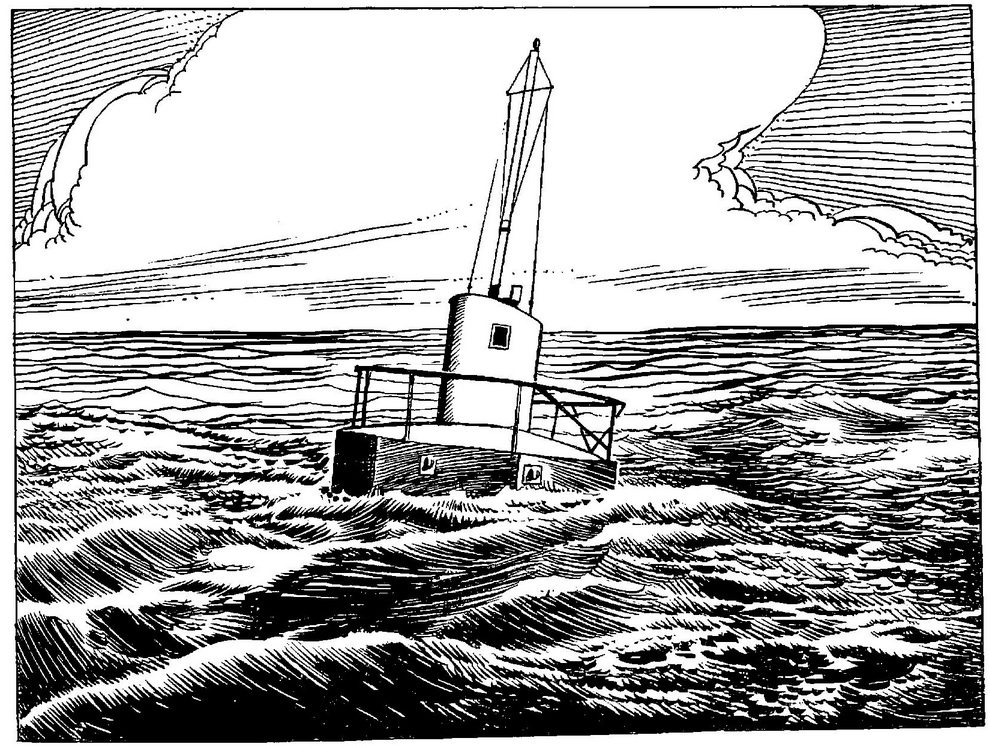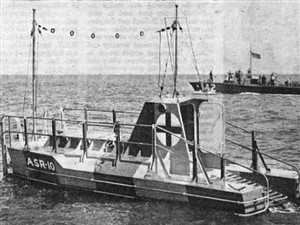The Luftwaffe's rescue buoy (Rettungsboje) was designed to provide shelter for the pilots or crew of aircraft shot down or forced to make an emergency landing over water.

A Luftwaffe rescue buoy at sea
History
The buoys were developed for flyers of the Luftwaffe brought down while operating over the English Channel, and were constructed under the direction of the German Ministry of Air Navigation in 1940 at the suggestion of Generaloberst Ernst Udet, Director-General of Equipment for the Luftwaffe.
The initial buoys were a simple design, 2m high, and 1m x 5m in size, offering little in the form of shelter. A flag pole allowed a flag or lamp to be hoisted, supplies included a basic medical kit, iron rations, water, life jackets and ropes.:91
A new delux Buoy was designed and 50 were anchored in the English Channel during 1940.:93

The interior of a Luftwaffe rescue buoy
Design of improved buoy
The buoys were of square or hexagonal construction and had a floor space of about 43 square feet with an 8-foot cabin rising above the float. On the upper deck of this cabin, there was an oval turret 6 feet high with a signal mast carrying a wireless antenna. Tube railings to which the distressed flyers could cling ran along the outer circumference below and above the water line. A ladder led up to the turret, in which there was a door opening into the cabin below.
A 320-foot red and yellow striped rope anchored the buoy at a fixed location, but allowed a limited drift, thereby indicating the direction of the current to aircraft in distress. The buoy was painted light yellow above the water line, and red crosses against white oval backgrounds were painted on each side of the turret.:91

--------------
(Translator)
The base had four teaspooned bunks, warm clothes and footwear, sideburns, medicines, 25 l of fresh water, iron doses for four men for several days. Warm food could be made with a digester that worked with alcohol jar capsules. In addition, the ferry had an emergency radio transmitter, a light gun with lightning strikes, and signaling devices to indicate that the ferry was rescued. There was a red flag in the tower of the day, red and white at night. The raft accessories also included patching tools and hand pump for leakage.
As war progressed, the air carriers of both sides were rescued on these rafts. The German rescue boats (Flugsicherungsboote) took the opportunity to visit the lifeboats to check their flight crew.
--------------
The cabin accommodated four persons comfortably for several days, and in an emergency, the crews of several aircraft could be taken care of. It was electrically lit by storage batteries, but in case of a breakdown kerosene lamps or other lighting devices were provided. There were two double-deck beds and adequate cupboard space for first-aid equipment, dry clothing and shoes, emergency rations, and a water supply. Hot food could be prepared on an alcohol stove. Cognac to relieve chill and cigarettes to quiet the nerves were also provided. Games, stationery, playing cards, etc. afforded diversion until rescue was effected. Depleted supplies were always immediately replaced upon the arrival of the rescue ship. A tubular lifeboat was available for transferring the downed aviators from the buoy to the ship.

Signalling was accomplished by hoisting a black anchor ball and a yellow and red striped flag on the mast during the day. At night, red and white lights in the turret indicated that rescued men were on board. A white anchor light on the mast was visible for 3,000 feet or more. SOS signals giving the location of the buoy were automatically sent out by an emergency wireless transmitter. Signal pistols with red and white lights, white-light parachute flares, or a smoke, distress-signalling apparatus completed the signalling equipment. Other equipment included plugs to stop up bullet holes in the walls of the cabin and a pump for the expulsion of seepage.
Rescue
Being in fixed locations, they could be checked one or twice a day and if occupied a seaplane or Flugsicherungboot (high speed launch), could be summoned.:92
They saved many airmen that ships or seaplanes might have been too late to rescue.:93
Defence usage
A rescue buoy was incorporated into the harbour boom at Braye Harbour in German occupied Alderney, reputedly manned by three men armed with a machine gun.:95
In Film
Rettungsboje have appeared in films from the World War II period: We dive at dawn (1943) and One of our aircraft is missing (1942).
Ei kommentteja:
Lähetä kommentti
Kaikenlaiset kommentit ovat tervetulleita.